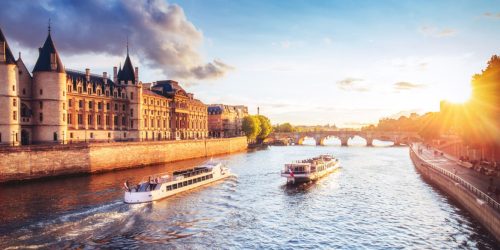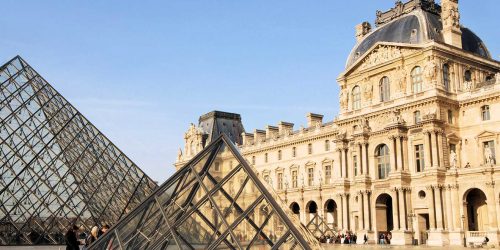The Art Lover’s Guide to Paris: Top Museums You Can’t Miss
Exploring the city’s renowned museums never fails to feel like stepping into a world of beauty, history, and emotion. From monumental classics to modern masterpieces, each museum offers not only art but a unique experience. Here is a deep dive into four iconic Parisian museums, complete with favorite works, essential tips, and insider details to ensure an unforgettable visit.
1. The Louvre Museum
Overview and Location
- Address: Rue de Rivoli, 75001 Paris, France
- Atmosphere: The Louvre, once a royal palace, combines grand Renaissance architecture with the iconic glass pyramid in its courtyard. It’s breathtaking to behold and has a blend of historical gravitas and contemporary flair.
- How to Get There: Take Metro Line 1 or 7 to Palais Royal-Musée du Louvre. If you enjoy walking, the Louvre is within a scenic stroll along the Seine, surrounded by Paris’s historic heart.
Highlight Artworks and Personal Experiences
- “The Mona Lisa” by Leonardo da Vinci
- About: Possibly the most famous painting in the world, the “Mona Lisa” is relatively small yet incredibly impactful. Its subtle mystery draws thousands of visitors daily.
- My Experience: Seeing her in person, with the attentive crowd pressing around, was surreal. Her gaze seems to follow you no matter where you stand, adding to her allure. Despite the crowd, a sense of intimacy with the piece makes the visit worthwhile.
- Insider Tip: Visit during off-peak hours (early morning or late afternoon) to get a closer look without the usual throng.
- “The Winged Victory of Samothrace”
- Description: This ancient Greek sculpture depicts Nike, the goddess of victory, dramatically poised on the prow of a ship.
- Personal Reflection: Ascending the grand staircase towards her feels like a cinematic moment. The sheer power and energy emanating from the sculpture are astounding, and I found myself entranced by the sense of motion in her form.
- Photo Tip: Capture her from below for a dynamic angle that emphasizes her grandeur.
- “The Raft of the Medusa” by Théodore Géricault
- About: This enormous painting recounts the tragic story of a shipwreck, focusing on survivors in a moment of desperate hope.
- Personal Insight: Standing before this piece, it felt like witnessing an intense drama unfold. The detail, the horror, and the sense of despair are palpable, capturing both human vulnerability and resilience.
- Worth Knowing: Géricault reportedly interviewed survivors and studied cadavers to capture this raw realism.
Visitor Tips
- Hours: Open every day except Tuesday, from 9:00 am to 6:00 pm. Extended hours on Wednesday and Friday until 9:45 pm.
- Ticket Information: €17 online, €15 at the door. Advance booking is highly recommended to skip the line.
- Dining and Amenities: The Louvre has multiple cafes, including Café Marly with views of the pyramid. The museum also features a bookstore and a gift shop.
- Guided Tours: A guided tour provides insightful context, highlighting key works while avoiding the overwhelming nature of the Louvre’s vast collection.
2. Musée d’Orsay
Atmosphere and Setting
- Address: 1 Rue de la Légion d’Honneur, 75007 Paris, France
- Setting: Located in a stunning former train station, the Musée d’Orsay combines industrial architecture with elegance. The giant clock in the main hall offers both charm and a reminder of the station’s history.
- How to Get There: The RER C train line stops right at Musée d’Orsay station, making it an easy addition to your itinerary if exploring the Left Bank.
Must-See Artworks
- “Starry Night Over the Rhône” by Vincent van Gogh
- Overview: Van Gogh’s depiction of starlit skies and reflections in the Rhône offers a dreamy view of a calm evening.
- Personal Experience: Seeing the colors swirl in person, I felt transported to that riverside night. Van Gogh’s brushstrokes make the stars seem almost alive, creating an emotional, almost serene experience.
- Fun Fact: This piece was painted near Arles in southern France, capturing Van Gogh’s fascination with light and color.
- “Olympia” by Édouard Manet
- Details: Controversial in its time, “Olympia” shows a reclining nude gazing confidently, defying traditional notions of modesty.
- Reflection: I was struck by Olympia’s unapologetic gaze. The painting broke barriers, portraying women with a new agency. The simplicity of the background enhances her striking figure.
- Interesting Angle: Manet’s work was initially scandalous, as Olympia’s defiant gaze challenged societal norms of the 1860s.
- “The Ballet Class” by Edgar Degas
- About: Degas captures the discipline and beauty of dance in this bustling yet organized ballet class.
- Personal Insight: As a lover of performing arts, I found myself enchanted by Degas’ delicate brushstrokes that seem to capture movement in a still image. It’s a testament to the dedication and beauty of ballet.
- Recommendation: Degas’ works highlight ordinary, intimate moments. It’s a refreshing break from the grandeur of many other works in the museum.
Visitor Information
- Hours: Open 9:30 am to 6:00 pm Tuesday through Sunday, with extended hours on Thursdays.
- Tickets: €16 standard entry, discounts available. Combined entry with Musée de l’Orangerie is €18.
- Dining: Try Café Campana, located behind the large clock, for a unique dining view.
- Guided Options: Consider themed tours focusing on Impressionism, where guides often share lesser-known facts about each piece.
3. Centre Pompidou
Location and Unique Vibe
- Address: Place Georges-Pompidou, 75004 Paris, France
- Atmosphere: The building’s iconic “inside-out” design, with its exposed colored pipes, sets the Centre Pompidou apart as a unique architectural marvel.
- Getting There: The museum is a short walk from Rambuteau Metro (Line 11), surrounded by cafes and vibrant street life.
Noteworthy Artworks and Experiences

- “Fountain” by Marcel Duchamp
- About: Duchamp’s urinal-as-art redefined modern art by challenging what constitutes artistic expression.
- My Impression: This piece is both humorous and thought-provoking, challenging the viewer to question traditional art boundaries. Duchamp’s audacity inspires a new way of thinking about art.
- Historical Note: Originally displayed in 1917, this “ready-made” concept pushed art into the modern era.
- “The Frame” by Frida Kahlo
- Overview: Kahlo’s self-portrait in a folk-art frame blends her Mexican heritage with personal struggle.
- Personal Connection: Kahlo’s work has an emotional depth that pulls you in. The vibrant colors and intense expression on her face left me feeling both inspired and introspective.
- Cultural Insight: Kahlo used self-portraiture to explore identity and resilience, themes still powerfully relevant today.
- “Blue Monochrome” by Yves Klein
- Description: A large canvas painted in Klein’s patented shade of blue that evokes the endlessness of the sky and sea.
- My Take: Staring into this solid blue feels like a meditative experience. Klein’s innovation with color, treating it as a subject itself, is mesmerizing.
- Fun Fact: Klein invented this specific shade of blue, known as International Klein Blue (IKB), to represent boundless space.
Essential Visitor Tips
- Hours: Open from 11:00 am to 10:00 pm, closed on Tuesdays.
- Tickets: €14 general entry; discounted tickets are available for students and youth.
- Views and Dining: The rooftop café offers one of the best panoramic views of Paris, especially at sunset.
- Extra Insight: Spend time outside the building as well, where local performers often create a lively, art-focused atmosphere.
4. Musée de l’Orangerie
Tranquil Setting in Tuileries Gardens
- Address: Jardin des Tuileries, Place de la Concorde, 75001 Paris, France
- Atmosphere: Nestled in the Tuileries Gardens, the Musée de l’Orangerie offers a peaceful escape from the bustle of central Paris.
- Getting There: Located near the Concorde Metro, or take a leisurely walk through the gardens.
Artworks to Immerse Yourself In
- “Water Lilies” by Claude Monet
- Details: Monet’s masterpiece series, housed in two oval-shaped rooms, extends over several large panels, enveloping visitors in a panoramic experience. The vibrant color contrasts of soft blues, purples, and greens, combined with the abstract reflections, create an almost dreamlike, meditative quality.
- Personal Reflection: Stepping into the circular rooms and seeing these massive works enveloping the walls felt like entering Monet’s serene garden. The tranquility of the water’s surface, its reflection of light and the surrounding nature, allowed me to momentarily escape the world and immerse in pure beauty. It was awe-inspiring to think about the years Monet spent perfecting these serene landscapes.
- Fun Fact: Monet painted these series at his Giverny garden, with many inspired by his own water lily pond. He sought to depict the natural world as both tangible and ephemeral, emphasizing reflection, color, and light.
- “The Nymphs and the Satyr” by François-Auguste Rude
- About: This sensual, romantic sculpture captures the mythological story of a satyr attempting to embrace two nymphs. The skill and movement portrayed in this piece evoke intense emotions.
- My Take: The fluidity of the nymphs’ hair and the strong, almost desperate expression on the satyr’s face gave this work a certain energy that made me feel as though it were about to come to life. The contrast between the softness of the figures and the tension in the satyr’s grip was fascinating.
- Historical Insight: Rude was a master of Romanticism, and his ability to capture both the sensuality and tension of classical mythology is one of the key reasons this sculpture is considered a standout piece.
- “The Artist’s Studio” by Gustave Courbet
- Description: Known for his Realist style, Courbet’s “The Artist’s Studio” is a massive canvas depicting an artist at work. It showcases not only the artist’s creative process but also represents a cross-section of society—his friends, patrons, and a range of characters.
- Reflection: This painting fascinated me because it’s not just an artistic statement; it’s a political one as well. It serves as a critique of the art world and society itself. The figures surrounding Courbet, some of which are ambiguous, left me pondering the role of the artist in society and the various influences on creativity.
- Insight: Courbet’s work often shocked critics due to its unapologetic realism, but his dedication to representing life as it truly is remains a cornerstone of modern art.
Visitor Information
- Hours: Open daily from 9:00 am to 6:00 pm, closed on Tuesdays. On Mondays and Wednesdays, the museum tends to be quieter, ideal for a more relaxed visit.
- Ticket Price: Standard admission is €12.50, but there are discounts for students, children, and those under 18. It’s also free for EU residents under 26.
- Additional Information: The museum’s small size compared to the Louvre makes it a perfect destination for a focused experience. I appreciated the calm atmosphere—it was less crowded, which allowed me to linger over the works without the pressure of larger crowds.
- Dining: Although small, the museum has a café where you can enjoy a coffee and pastries, especially nice during breaks between viewing art.

Why These Museums Are a Must-Visit for Any Art Lover
Visiting these four Parisian museums—The Louvre, Musée d’Orsay, Centre Pompidou, and Musée de l’Orangerie—has been an unforgettable journey through art history. Each museum offers something unique: The Louvre’s vast collection of classical masterpieces; the Musée d’Orsay’s breathtaking impressionist masterpieces; the Centre Pompidou’s cutting-edge modern art; and the Musée de l’Orangerie’s serene, immersive experience with Monet’s water lilies.
Paris is a city where art is not only seen but felt. From the sublime sculptures at the Louvre to the expressive canvases of the Impressionists, each museum brings art to life, telling stories that transcend time and space. I came for the art, but left with a deeper understanding of the historical, cultural, and emotional significance that each piece carries.
Pro Tips for Visiting the Museums
- Book Tickets in Advance: Most museums offer online tickets, which are not only cheaper but also let you skip the long lines. This is especially helpful at the Louvre, where lines can be overwhelming.
- Visit Early or Late: To avoid the crowds, I recommend visiting these museums first thing in the morning or right before closing. Not only will you experience the art in peace, but you’ll also avoid the peak tourist hours.
- Guided Tours: For a deeper understanding, consider booking a guided tour. Many museums offer both audio guides and expert-led tours, which can enhance your appreciation of the artwork. For example, the Louvre’s guided tours are invaluable for helping you understand the historical context of its pieces.
- Check for Discounts: Many museums offer free admission on certain days or for specific age groups, such as the Musée d’Orsay’s free entry for those under 26. It’s always worth checking before you go to save some money.
As I reflect on these visits, the experience of wandering through these museums always makes me feel like I’m part of something larger. It’s not just about looking at paintings or sculptures—it’s about connecting with the emotions, the history, and the stories behind them. Paris, with its unparalleled collection of art, never ceases to amaze me. Whether you’re standing face to face with the “Mona Lisa,” feeling the energy of Van Gogh’s swirling skies, or losing yourself in Monet’s water lilies, Paris offers an intimate encounter with art that is unlike anywhere else in the world.





